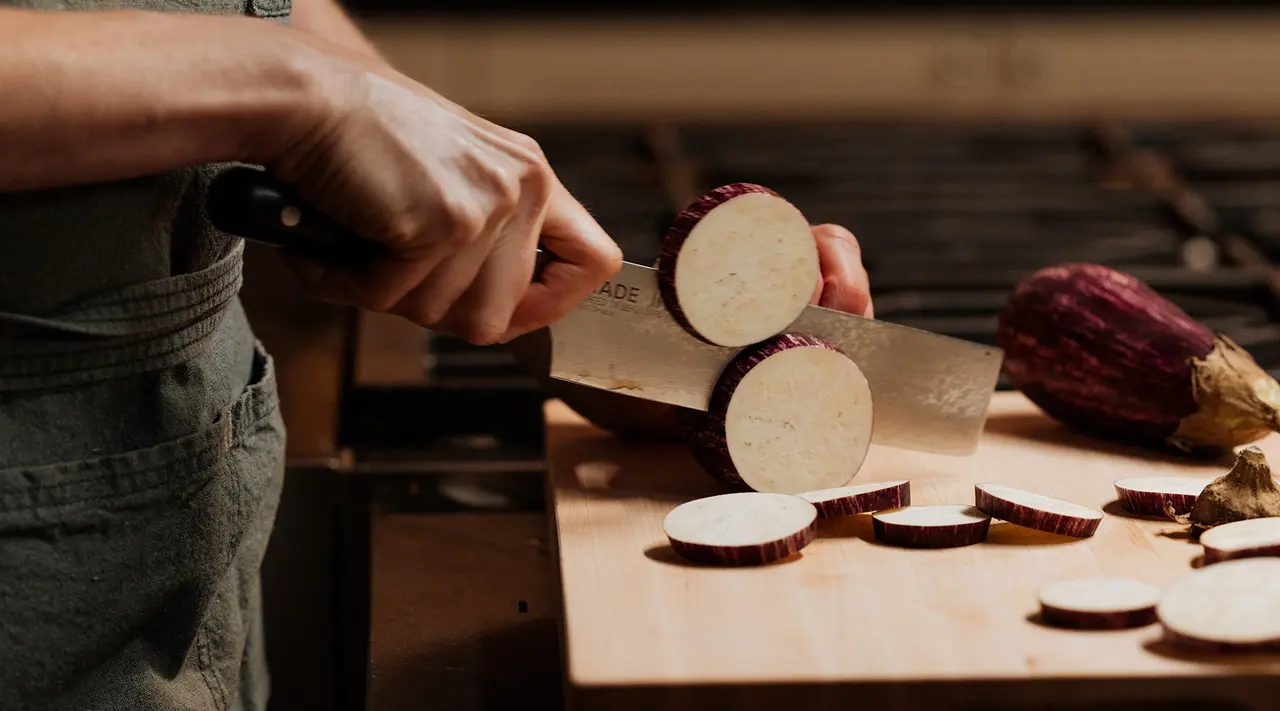Eggplant is a vegetable from the nightshade family, the same group of plants that yields tomatoes, zucchini, and okra. Not only is it incredibly easy to incorporate into many dishes, but it's also a great source of nutrients. It comes in many varieties, such as the popular Chinese eggplant, which is thinner and has a slightly sweeter flavor.
Whether you plan to use eggplant in a baked pasta dish, stir-fry, or kebab, knowing how to properly cut this vegetable is a must.
What Does Eggplant Taste Like?
Describing the flavor of eggplant can be difficult, especially since it can take on different flavors based on how it's prepared (roasted, boiled, sauteed, grilled, etc.).
In general, however, eggplant has a very mild flavor that is similar to that of any other summer squash or zucchini. Many people enjoy cooking with eggplant because it will absorb other flavors during the cooking process.
Can You Eat Eggplant Skin?
While some vegetables have a tough skin that is practically inedible, the good news about eggplant is that its purple skin is fully edible. In fact, it is recommended that you leave the skin on an eggplant when cutting it because the skin is rich in nutrients. It also helps your pieces keep their shape. Likewise, the skin doesn't have much of a flavor (especially when it's roasted), so not peeling the skin can save you time in prepping your recipe. The seeds of an eggplant are edible, too and don’t need to be removed.
How to Cut an Eggplant Four Ways
There are four main ways to cut eggplant: planks, cubes, rounds, and sticks. The method that's right for you will depend on your recipe and personal preference. As always, using a quality knife is key. We like the Nakiri for this task as its flat, straight blade is designed for chopping vegetables.
How to Cut an Eggplant into PlanksEggplant planks may be ideal when roasting eggplant "steaks" or in other recipes that call for larger pieces of the vegetable. Cutting an eggplant into planks is relatively easy.
Start by slicing on the stem end, then cut the vegetable in half. From there, you can simply cut vertical slices out of each half of the eggplant to your desired thickness.
How to Cut an Eggplant into CubesCutting eggplant into cubes is ideal for roasting or sautéeing. By cutting the vegetable into smaller pieces, you create more surface area to absorb flavor and seasoning. Plus, the eggplant will get nice and crispy on all six sides.
To cube eggplant, begin by cutting off the top stem. Next, slice the eggplant in half lengthwise. Then, cut the halves into smaller strips before slicing each strip horizontally to create cubes. The size of your cubes may vary depending on what your recipe calls for, but 1-inch cubes are common.
How to Cut an Eggplant into RoundsRounds are another common way to cut eggplant, especially when roasting the vegetable or making eggplant parmesan. This is also among the easiest ways to cut an eggplant.
To begin, cut off the stem, then, continue slicing the eggplant horizontally from one end to the next. To make this process as fast and efficient as possible, keep the blunt tip of your knife on your Butcher Block and rock the blade up and down as you slice. You can cut the rounds as thick or as thin as you'd like, depending on the dish.
How to Cut an Eggplant Into SticksIf you're making eggplant fries, your recipe will probably call for eggplant sticks. The best way to do this cut is to remove the stem and then cut the eggplant as if you’re making planks. From there, you can cut each individual plank into strips—which can be seasoned and made into delicious eggplant fries in your oven. This is also a good method for cutting eggplant to stir-fry.
Ready to Cook?
As you can see, there are many different ways to cut and prepare eggplant for your next dish. No matter how you'll be using eggplant in your next recipe, it's important to have the right knife for the job. We offer a wide selection of knives to make prepping and cutting eggplant (among many other vegetables) quick, easy, and safe. Check out our Knife collection to find the perfect set for your kitchen.






























